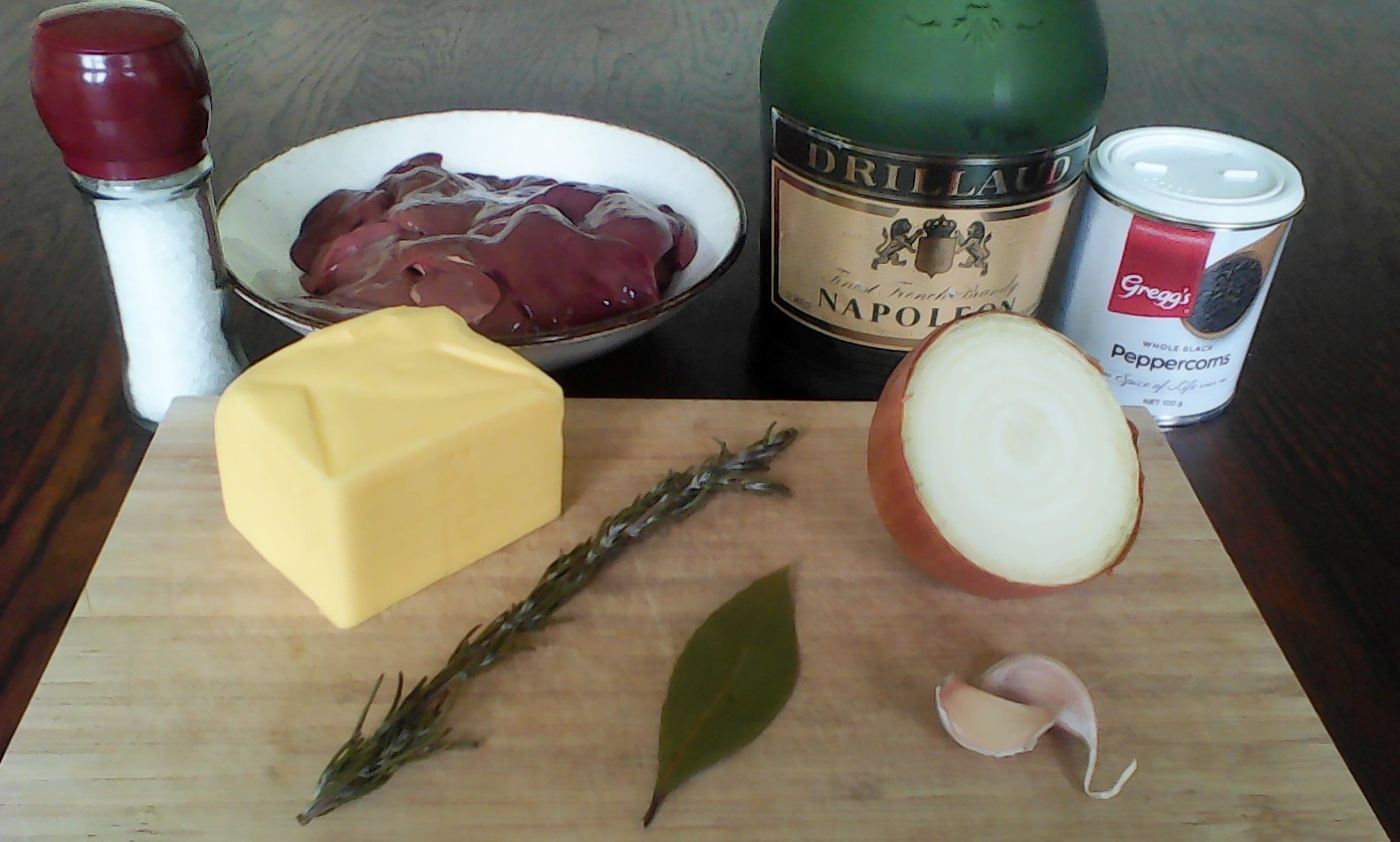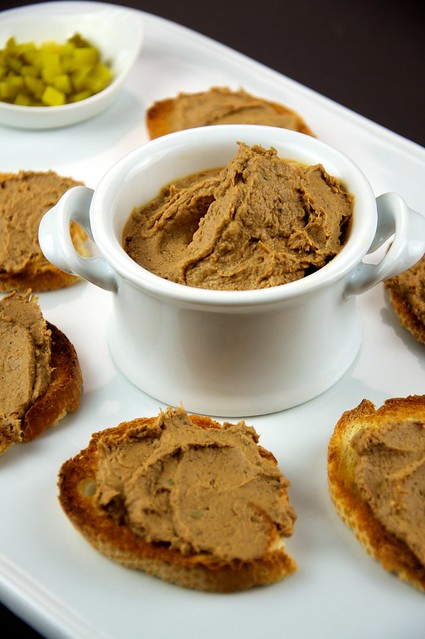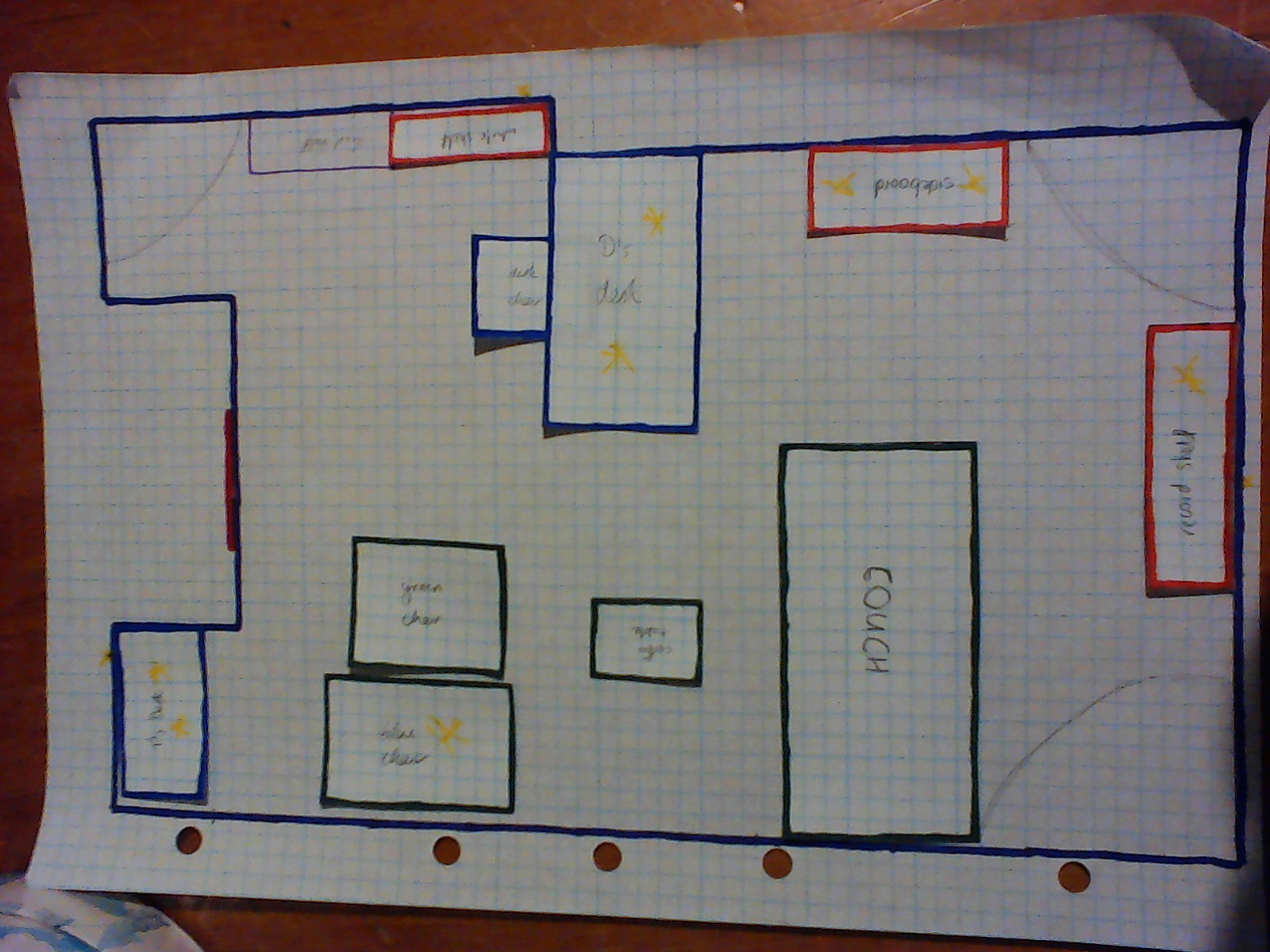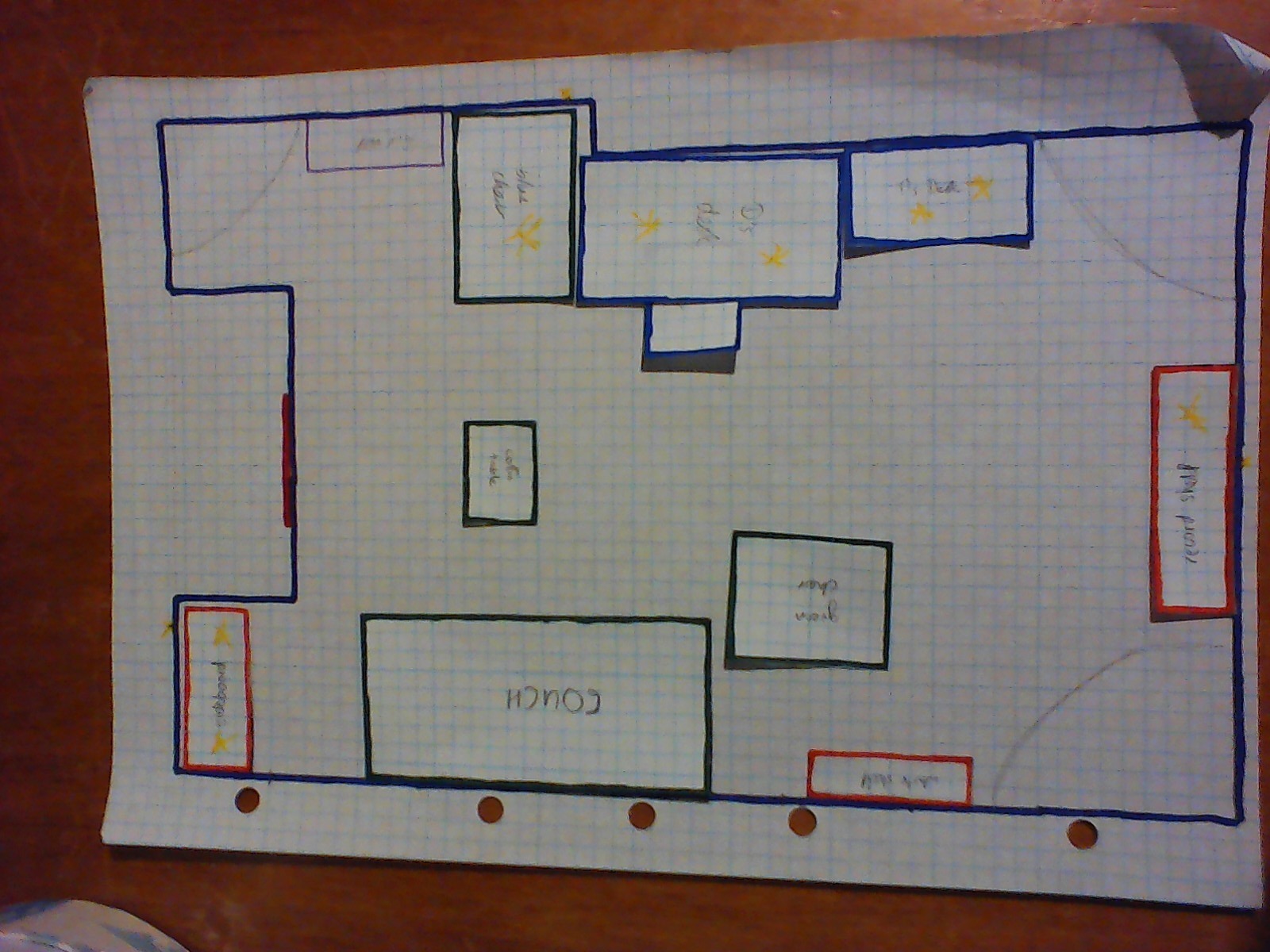
True economy consists in always making the income exceed the out-go. Wear the old clothes a little longer if necessary; dispense with the new pair of gloves; mend the old dress: live on plainer food if need be; so that, under all circumstances, unless some unforeseen accident occurs, there will be a margin in favor of the income.
P.T. Barnum
Chicken Liver Pâté For Those Who Don’t Like Liver
Chickens are tough. Try eating a chicken’s foot, and you’ll really know what hardy means. One of the strongest bits of a chicken (in my entirely unscientific survey) is the liver, which is packed full of iron, i.e. what they make steel out of. Chickens are tough.

In a modern version of the ancient practice of eating someone or something to take on his, her, their or its qualities, I sometimes eat chicken livers, in an attempt to take on their iron levels. Liver tasting as it does, I eat it in the form of chicken liver pâté. And since the pâté in the shops is generally mostly made up of Things Which Are Not Chicken Livers, I have at last given in and started making my own. Bonus: it’s a lot cheaper than the commercial version and you can customize it to your taste. (Unless of course you are a vegetarian or vegan.)
You will need some chicken livers, about 400-500g (a pound-ish, imperialists); half an onion, chopped up small; two fat cloves of garlic, ditto; about 150g butter (say 5oz); 1/2 teaspoon salt; 1 or more teaspoons of peppercorns (depending on how much you don’t like the taste of liver); plenty of herbs (I used rosemary and a bay leaf, but sage and thyme are also suitable); and 2 tablespoons brandy – optional, but it does help disguise the liver taste. Port would also be good.

You will also need a frying pan and (alas!) a blender. It always used to peeve me when people offered “super-simple” recipes that required equipment I didn’t have, so my apologies if this won’t work for you. A hand-mincer and much stirring may yet do the job.
Melt 1/3 of the butter in the frying pan, and fry the onion and garlic until the onion looks fairly cooked. The bay leaf can go in here too, if you’re using one. While the onion fried, I used the blender to turn a teaspoon of peppercorns into pepper-dust (like watching a snow-globe full of midges), debated whether to add more pepper, and decided not to. I am still not sure this was the right decision, but after all, one can always add more pepper when one eats it.

Once the onion is cooked, you scoop it out of the pan (a slotted spoon is useful here) and put it aside, adding the livers to the pan in its place. Cook for about five minutes, until they look nice and brown. You can cut into a lobe to see if it’s cooked through: a bit pink in the middle is ok, but you don’t want it bleeding. (Helpful rule of life: if it’s bleeding, don’t eat it.)
When you are satisfied with the cookedness of the livers, plop them into the blender. Add the onion, being careful to remove the bay leaf first. Blend until no longer lumpy and then add the rest of the butter (goes in easier if it’s softened) and any herbs and spices you haven’t already added, along with the salt and the brandy (or port). Blend till smooth and creamy and then spoon into whatever container takes your fancy – bowls are nice for general presentation; jars are more practical if you’re not likely to eat it all at once.
Now, the traditional thing to do is to pour melted clarified butter over the top, and this is certainly of use if you are putting it away in ye olde cold stone pantry for some time. Personally, I don’t find a layer of yellowed fat on the top of my food to be very appetizing, so I leave that stage out. Chacun à son goût.
This is good in a sandwich with sliced tomatoes (with, of course, plenty of pepper) or spread on hot, hot toast – preferably Vogels. Crackers are another excellent form of pâté consumption, though I generally like something more on top. Again, tomato is good, as are cucumber and sometimes a little tasty cheese.

Having written this, I feel I would like to plead for a more rational spelling of pâté, which just says “French was here.” Maybe not pate (that one is already taken, and eating the tops of people’s heads is frowned on, provident Fejee or not), but something. Partay? Putty? I remember from my brief career as a French student that the circumflex – on the â – often means there used to be an s in there, which English has usually kept. Pâté = paste. Would pâté de foie gras be as popular if it was advertised as “fat liver paste”? I think not.
The Furniture 15-Puzzle
I love rearranging furniture. I moved frequently in my childhood and youth, and even then I still found myself rearranging my room, or swapping rooms in order to effect a change. And I’m sure it’s not just me. No, rearranging the furniture is a deeply ingrained human activity, at least in those societies which use furniture.
 When we moved in to this house, some eight months ago (I have just about recovered from the tea trauma, thank you), we carefully figured out what appeared to be the perfect living-room furniture arrangement – nay, more than that, the only workable arrangement. There were so many variables to take into account – electricity, heating, lines of sight, lines of movement, space for storage access etc etc.
When we moved in to this house, some eight months ago (I have just about recovered from the tea trauma, thank you), we carefully figured out what appeared to be the perfect living-room furniture arrangement – nay, more than that, the only workable arrangement. There were so many variables to take into account – electricity, heating, lines of sight, lines of movement, space for storage access etc etc.
I resigned myself to never moving the furniture again – in that room, at least, which is where the largest part of our furniture resides. But as time went on, I grew increasingly frustrated with the blinding sunlight bouncing off my desk, and decided that changes could and would be made.
The prospect of moving the furniture is very invigorating – to me at least. On the other hand, the execution can also prove tiring, which is why I made a scale map of the room and its furniture and decided on the layout by proxy first. (Because a little slip of paper weighs considerably less than a large desk, a shelf full of books, or a steel-based armchair.)
There was another constraint to bear in mind, however: I don’t like sitting with my back to the door. I can do it if I have to, but I tend to stay wary, which doesn’t work particularly well for getting into ‘flow’. Side on is fine, even three-quarters I can deal with, but having my back straight on to the entrance makes me uneasy. This may seem silly to you, but tell it to Wild Bill Hickok.

I went through many many frustrating iterations before deciding – rather selfishly – that since the main reason for the rearrangement was to have my desk in a better location, I should decide that first and work everything else around it. Given the size of the desk, it would have to be facing a wall, or it would ‘eat’ too much of the room.
Wall #1 has a fireplace in it – no go. Wall #2 is where the desk was to begin with, and while I could slide it along so it wasn’t entirely under the window, the sun problem would still be in play for at least part of the day – the part when I do most of my writing. Wall #3 is directly between the front door and the door to the rest of the house – good for keeping an eye on things but who gets anything done in a corridor? Wall #4 it would have to be, but there was a problem: Wall #4 faces the front door, so anyone facing the wall would have their back to the door. Twitch, twitch.

I tried to re-deal the paper slips to come out as anything but a dead man’s hand. It wasn’t working. Eventually I left the graph paper and tried out some reality. I went around the room, scrunching down to chair height and staring glassily at the walls. The Caped Gooseberry either didn’t notice or tactfully decided to say nothing.
At last, I found a spot I felt comfortable, half-way down Wall #4, where the front door was not right behind me, and the sun would not interfere. Bonus: it was near a source of electricity.
Once that was in place, the rest of the room wasn’t too hard to arrange. I even managed to place the Caped Gooseberry’s desk between me and the ‘corridor’ – thus giving my subconscious another reason to relax.

After that, of course, there was nothing to do but spend the next three hours or so shoving furniture around. (I like shoving around things that are bigger than me.) Happily the two heaviest bookshelves and the steel-based armchair didn’t need to move for this new plan.
I admit that it would have been more sensible to wait a day or two to begin, rather than start moving things around an hour before bedtime, but when I get the furniture-moving bit between my teeth there is no stopping me. As Nicole Holofcener said, “If a woman gets insomnia, you never know where you’re going to find her furniture the next morning. It’s primal.” I would add that while insomnia can be a cause of furniture moving, it can work the other way, too. Too busy moving furniture: sleep will have to wait.

Well worth the loss of sleep, too. The new arrangement is much easier to get around in and a much more relaxing space to be in. I can sit at my desk without being blinded by the sun, and my notes don’t fade so fast if I leave them out. So why, I found myself asking, didn’t we find this layout the first time? Probably because of the one defect this plan has: in order to watch something off the computer on the TV, you now have to run a cord from one corner of the room to the opposite corner. First world problems. Doesn’t bother me.
As another added bonus, I am now feeling the urge to purge rising again. Opening up the space has made it all too clear just how much stuff there is in this room (and let us be frank, this isn’t the only room). Bring on the katharsis!
